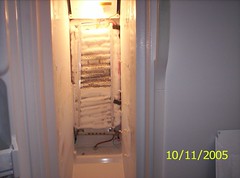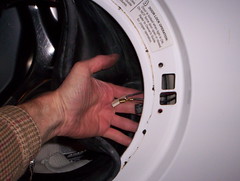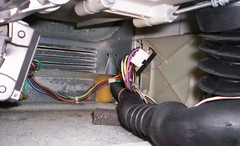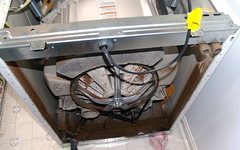Bob Kazmerchek wrote:
Hi,
My 2001 Whirlpool refrigerator has stopped cooling anything. It still runs and I believe the fan must be still working – but the air being blown into the icebox is not cold. Nothing freezes and nothing is cold in the main part of the refrigerator. Is it worth it for me to pay a repairman $65 just to come look at it or should I just buy a new one.
Thanks!
Bob K.
P.S. I vacuumed any dirt that was on the coils but that didn’t help.
7 years for a fridge seems so short.
My first move on this fridge would be to see if the compressor is actually running and not just doing the infamous hummm-CLICK. Once I verify that the compressor is starting and running normally, then it’s time to tear apart the freezer. Everything comes out and the back wall gets removed so I can feast my calibrated eyeballs lovingly upon the evaporator coil while the compressor is running. What I’m looking for here is the frost pattern on the coil. Based on your complaint, I’d expect to see one of three situations (doesn’t matter if your fridge is a side-by-side or top-and-bottom, the frost patterns are the same in all configurations so don’t let the variations in the pictures confuse you):
 No Frost At All
No Frost At All
This is bad. Remember, we’re looking at this coil with the compressor running, so if everything was peachy, I’d expect to see a light sheen of frost on 2/3 of the coil. No frost at all means either the compressor is “plum wore out” (that’s a technical term, please don’t use it unless you have a valid EPA refrigeration certificate) or the freon has leaked out. Either way, for most refrigerators today, that means you’re going shoppin’.
 Single Glob of Frost or Iceball
Single Glob of Frost or Iceball
This is also bad, and same deal as above. Same remedy, too.
 Heavy Frost on the Coils
Heavy Frost on the Coils
This is good! This indicates a defrosting system failure which is a simple control problem. It also means that the sealed system (compressor, evaporator coil, and all associated tubing) is fine as wine in summertime. Defrost system problems are easy fixes that anyone with a pulse can do with maybe just a little help from their friends. The problem will either be the defrost timer (or Adaptive Defrost Control board, if so equipped), the defrost thermostat, or the defrost heater. To locate these parts in your fridge, check out these cool, interactive parts diagrams.
If you’re still confoosed about disassembly or about what you’re seeing, come talk to us in the Samurai Appliance Repair Forums for personalized, interactive help from Master Appliantologists, including yours so very freaking truly.
To learn more about your refrigerator, or to order parts, click here.




